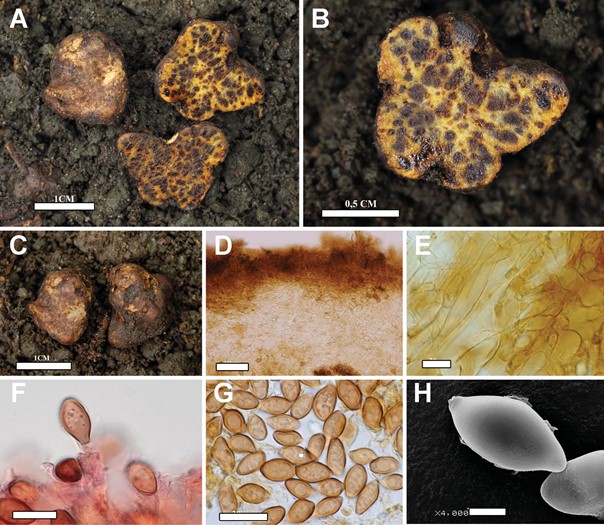Paralpova artikutzensis Cabero, D. Moreno-Mateos & P. Alvarado, in Alvarado, Cabero, Moreno-Mateos, Vizzini, Alonso, Lebeuf, Siquier & Vidal, Mycologia 113(4): 835 (2020)
MycoBank number: MB 833077; Index Fungorum number: IF 833077; Facesoffungi number: FoF 12591;
Typification: SPAIN. NAVARRE: Goizutea, Artikutza Reserve (42°12′50″N, 1°47′48″W), 680 m asl, in a forest of Fagus sylvatica, in a slope with acidic ferruginose soil, 27 Jun 2018, J. Cabero & D. Moreno-Mateos, JC180627NR (holotype AH:49154, isotype FCO-Fungi :41).
Diagnosis: Medium-sized sequestrate hypogeous basi- diomata with an intense pleasant fruity smell (some- times even after drying), gleba yellowish, two-layered peridium with a prosenchymatic peridiopellis about 200 µm thick, basidiospores 17.5 × 10 µm on average. Associated with Fagus sylvatica.
Etymology: artikutzensis, from Artikutza (Navarre, Spain), the place where this species was first found.
Description: Basidiomata (FIG. 3A–C) 13–28 mm wide; hypogeous (often found 3–4 cm deep); compact; first subglobose and then lobed, with a small basal depression; surface smooth, matt or dull yellowish brown. Intense pleasant fruity odor, recalling that of mandarin orange. Peridium thin, not detachable; concolor with the surface or slightly darkened. Glebal chambers about 1.8–2.8 × 2.5–3.7 mm; filled with dark brown or blackish gel; more or less symmetric but lacking a well-delimited perimeter. Trama yellowish. Peridium (FIG. 3D–E) 0.7–0.8 mm thick; with two layers: (i) peridiopellis 230 µm thick, prosenchymatic, made of entangled hyphae arranged more or less parallel to the surface, irregularly cylindrical, septate, bifurcate, with brownish-yellow parietal content, about 2.5–3.5 µm diam, without clamp connections, and of rugose or granulose, thin-walled, short cells with inflated or clavate tips growing on the surface, and (ii) subpellis 570 µm thick, pseudoparenchymatic, formed of subglobose and angular elements, as well as irregularly cylindrical hyphae with parietal yellowish pigments. Trama made of polygonal and subglobose elements measuring 13.0–17.5 × 30.5–40.5 µm, with occasional irregularly cylindrical septate hyphae with parietal brownish yellow pigments. Hymenium densely packed but lacking a palisade organization, with septate and bifurcate hyphae bearing basidia that are soon collapsing. Basidia (FIG. 3F) 7–10 × 2.5–3.0 µm; hyaline, with granulose content; subcylindrical or slightly claviform; mostly monosporic (but rarely also bisporic); rarely visible because of autolysis, with sterigmata measuring about 2–3 µm and presenting a concave tip. Basidiospores (FIG. 3G-H) (13.5–)15–19.5(–22) × (8–)8.5–10.5(–12) µm, 17.5 × 9.5 µm on average (n = 85), Qm = 1.82 ± 0.2; statismosporic, orthotropic and multi- guttulate; ellipsoid to claviform, fusiform, sinuose, inflated or asymmetrical; smooth; with a rounded (rarely papillate) apex and a slightly truncate base; sometimes with small hyaline remnants of sterigmata; brownish yellow with an intensely colored wall about 1–1.5 µm thick. Cystidia not seen. Clamp connections not seen.
Ecology and distribution: The only known collection (from Navarre, northern Spain) was found in acidic soil near Fagus sylvatica.
GenBank Accession Numbers: ITS = MN594297; 28S = MN594307; RPB2 = MN594778.
Notes: Paralpova artikutzensis is the only known species of Paralpova. Discovering additional species of this genus would help to know which features of P. artikutzensis characterize the whole genus and which ones are apomorphic features present only in this species.

Figure 3. A–H. Paralpova artikutzensis JC180627NR (holotype). A–C. Basidiomata. D. Peridium. E. Peridium elements. F. Spores attached to basidia. G. Spores in water. H. Spore under SEM. Bars: A = 1 cm; B = 0.5 cm; C = 1 cm; D = 100 µm; E = 10 µm; F = 10 µm; G = 20 µm; H = 5 µm.
